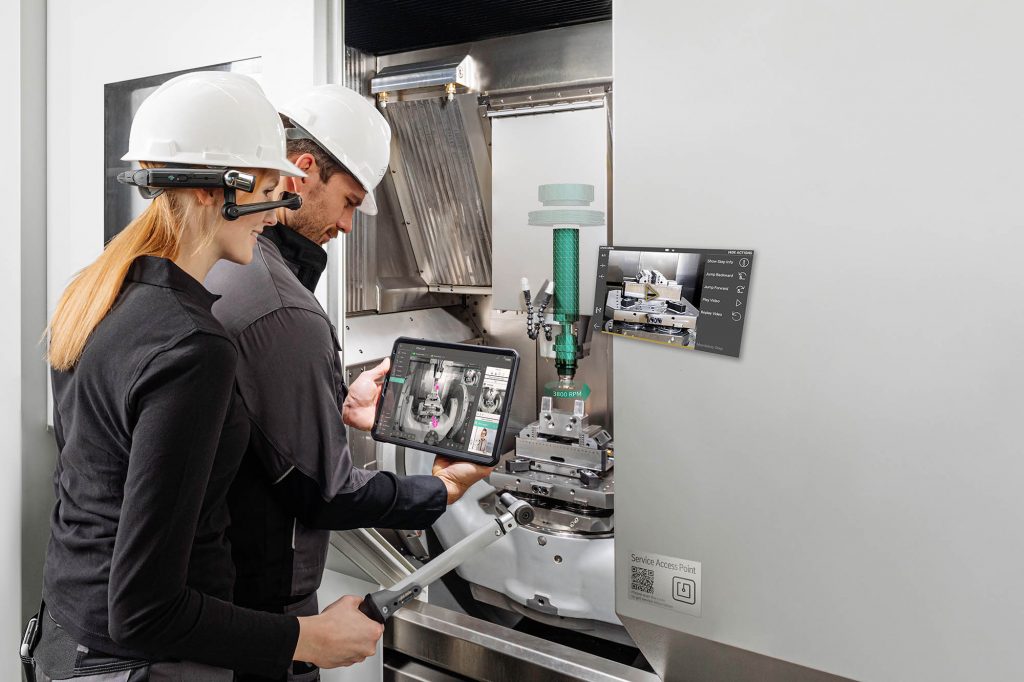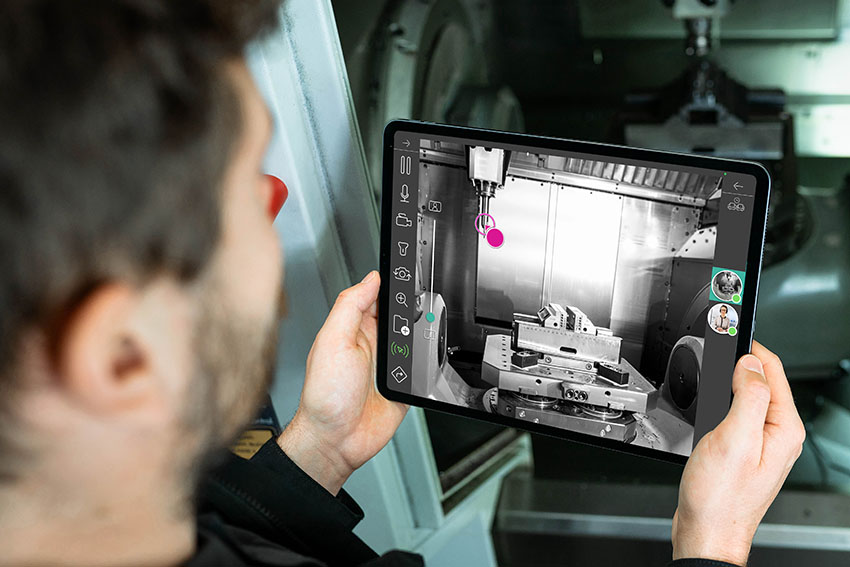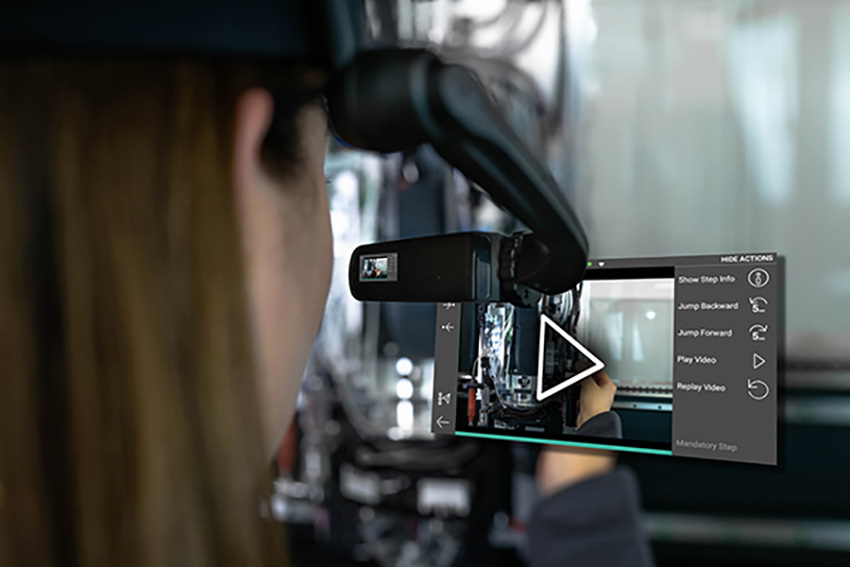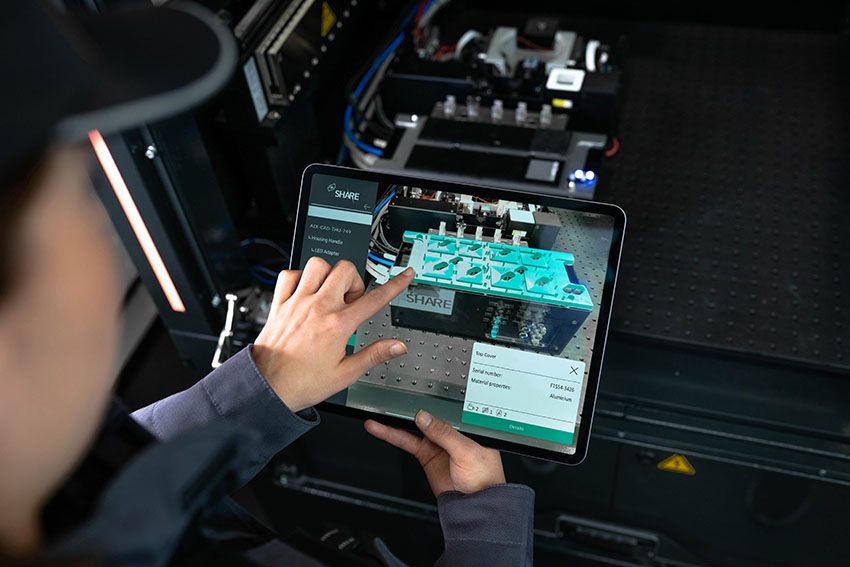oculavis was founded in 2016 as a spin-off of the Fraunhofer Society and RWTH Aachen University. Today, the company has grown to a team of more than 60 employees, who are constantly working on their vision to redefine interactions with machinery and equipment. 250+ customers from the mechanical engineering and manufacturing industry use oculavis’ solution to connect experts, technicians and end users worldwide to collaborate on machine-related issues.
Interview with Nico Swienty, Online Marketing Manager at OCULAVIS.
oculavis SHARE product video:
Easy Engineering: Which are the most futuristic products / solutions from your portfolio?
Nico Swienty: The core product of oculavis is the software platform oculavis SHARE (see figure 1). The solution unites industrial-grade Augmented Reality (AR) technology, remote expert support and standard work instructions. Remote expert support enables real-time video calls with AR annotations and integrated technical documentation. Standard work instructions provide machine operators with technical knowledge and empower them to master machine-related challenges independently with step-by-step instructions. The Augmented Reality Viewer is an X-ray viewer that visualizes parts, components up to entire machines and combines them with digital work content.
E.E: How will your products / solutions make work more efficient for users?
N.S: oculavis SHARE redefines the way service is done. The solution connects experts, service technicians, know-how carriers and end users of machinery and equipment worldwide with mobile devices to collaborate on related issues. In this way, machine builders can solve customer problems quickly and efficiently from a distance and are empowered to establish new digital business models in service. At the same time, cost- and time-consuming business trips are reduced, machine availability is increased and productivity is enhanced.
E.E: What are the characteristics of these products / solutions?
N.S: oculavis SHARE covers the entire lifecycle of machinery and equipment, such as acceptance tests, commissioning, ramp-ups, audits, training and troubleshooting. The AR based platform works seamlessly on PCs, smartphones, tablets (Android and iOS) and smart glasses. Hosting the solution on the cloud or on-premise suits the needs of an enterprise of any size. The solution maps organizational structures to the installed base of machinery and provides a simple approach to get in touch with assigned experts and asset managers. Roles and permissions can be defined individually so that new internal as well as external users can easily access the platform. The entire application can completely be white labelled. This option is particularly interesting for companies that want to reach their customers with an application that shows their corporate design and allows them to become the full-service provider of their own Augmented Reality solution.
E.E: What are the benefits for the users?
N.S: oculavis SHARE changes the way technical personnel interact with machines and how they carry out machine-related tasks. For example, recurring activities, such as repairs, assembly or set-up operations, commissioning and maintenance procedures can be executed independently by using digital step-by-step-instructions on smartphones, tablets or smart glasses (see figure 2). Enriched with video, screenshots and text instructions machine operators are guided through the process in a structured manner without the assistance of a third party.
In case that additional assistance is needed the assigned expert for the machine can support the operator at any time comfortably from the (home) office. AR annotations, the shared pointer and the navigation mode functionalities are specifically designed to meet remote requirements that allow a precise guidance in the video call. The guest user feature is extremely useful to easily invite further participants to the remote session. They can join directly via the mobile browser of their smartphones and tablets with just one click via a link and without having to install the app first. The expert can document all necessary steps in a case, so that important knowledge is stored and can be provided to other colleagues or send as a technical report to the end customer (see figure 3).
Overall, customers as well as machine builders benefit equally. Manufacturers offer fast and digital service that avoids unnecessary travelling and generates new revenues in sales, while end customers experience less downtimes of their machines and an increase of the overall equipment effectiveness.
E.E: How do you focus these ranges for the future?
N.S: We are constantly working on our software to provide the greatest possible benefits to our customers. Our strong background in the mechanical engineering industry allows us to focus on improving the current features and upcoming developments of oculavis SHARE always with an eye on usability of the platform as well as application possibilities in a wide range of industries from manufacturing and automotive, energy and utilities, chemistry and pharmaceuticals to industrial services. Thereby we listen carefully to our customers’ suggestions and proposals and work together to integrate these solutions and bring them to market.
E.E: How does the digital transformation affect your products / business?
N.S: Technological progress is both a driver and a basis for the digital transformation in industrial companies. Jobs are changing and tasks are becoming more complex. The innovation dynamics in technical areas and the advancing digitization require adjustments in the work organization and in the qualification of technical and managerial staff. The Corona pandemic has shown the power and speed with which companies around the world have redesigned processes with oculavis SHARE so that travel restrictions and distance regulations do not cause customer service. The experiences and resulting successes from real-time collaborations clearly show that digital solutions lead to more resilience and enable digital offerings that complement the sale of physical products with new revenues.
E.E: Tell us something about sustainability and efficiency in the future.
N.S: The topic of sustainability is attracting considerable attention, not least due to the decision to achieve climate neutrality in Germany by 2045. Companies are seizing the opportunity to make their operations more productive, maintain competitiveness and decrease CO2 emissions for a sustainable planet and future generations by reducing business travel. Remote processes have the potential to support this development and become the new standard for service, maintenance and quality tasks.
E.E: How do you think the future will look like in your field in the following years?
N.S: Reactive maintenance will be replaced by predictive maintenance in the future. Human expertise will play an essential role and with the help of artificial intelligence and sensors, a faster acquisition and evaluation of important data will be enabled. oculavis SHARE is the interface to this knowledge and facilitates access to service- and machine-relevant information. Maintenance intervals can be defined more precisely through this combination, which increases the operational availability of machinery and equipment to a maximum. The synergy of these factors will change the way service technicians work. Future generations, such as the Generation Y, expect digital solutions that enable location-independent working and a healthy work-life balance. In addition, the ever-increasing environmental awareness of younger generations is leading to a rejection of unnecessary travel.
E.E: What technologies do you think will grow this year / in the following years?
N.S: Visual technologies such as augmented reality are already market-ready and offer enormous potential that is not yet fully utilized. In the future, this potential can be used to provide visualizations of machines in trainings with video tutorials or in education courses conducted remotely in the technical center (see figure 4).
These visualizations are dynamically and can be enriched with real-time data in order to detect and illustrate avoidable defects of produced parts at an early stage before it is delivered to the customer. The combination of evaluated date with the human expertise and level of action optimizes the maintenance strategy, as well as better products and services, a larger customer base or new sources of revenue. Producing and processing companies already have the opportunities today to redefine interactions with machinery and equipment, with proven technologies and new collaboration forms tailored to industrial needs facilitated by oculavis SHARE.
CONTACT
OCULAVIS
Nico Swienty





